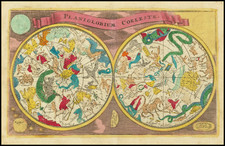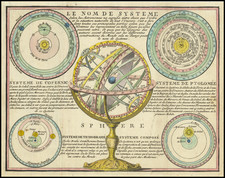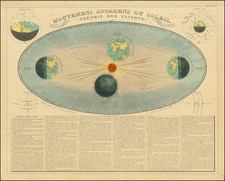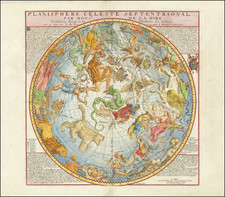Selenographic Phases of the Moon Based Upon The Writings of Tycho Brahe
Striking celestial chart, showing the selenographic phases of the moon, from Cellarius' Harmonia Macrocosmica seu Atlas Universalis et Novus, generally considered the greatest celestial atlas ever published.
This plate describes the phases of the moon as we now understand them, offered by Cellarius as a contrast to the Ptolomeic explanation for the phases of the moon with multiple orbits or "epicycles," which had dominated Astronomical theory prior to the 17th century. The image shows a Tychonian point of view, with the sun, moon, and the stars orbiting around the earth. The explanation for the phases of the moon is readily apparent here with the Sun's magnificent rays that streak out across the page. In the bottom left is a day-by-day accounting of the phases, while the lower right uses tangential lines to show that half of the moon is always in light, but that the angle visible from Earth is what changes.
Andreas Cellarius Harmonia Macrocosmica (first published in 1660) is generally regarded as one of the most spectacular cosmographical atlases that was published in the second half of the seventeenth century. The atlas was published in 1660 and 1661 by the Amsterdam publisher Johannes Janssonius (1588-1664), as a cosmographical supplement to his Atlas Novus. Andreas Cellarius had already started working on this atlas before 1647 and intended it to be a historical introduction for a two-volume treatise on cosmography but the second part was never published.
Andreas Cellarius was born in 1596 in Neuhausen and educated in Heidelberg. He emigrated to Holland in the early 17th century, and in 1637 moved to Hoorn, where he became the rector of the Latin School. Cellarius' best-known work is his Harmonia Macrocosmica, first issued in 1660 by Jan Jansson, as a supplement to Jansson's Atlas Novus. The work consists of a series of Celestial Charts begun by Cellarius in 1647 and intended as part of a two-volume treatise on cosmography, which was never issued.









![[ Orion / Canis Minor / Lepus ]](https://storage.googleapis.com/raremaps/img/small/102620.jpg)
![Idea dell' universo [Two-Sheet Cosmographical Chart]](https://storage.googleapis.com/raremaps/img/small/90009.jpg)



